160 years of history of gardeners and
flower breeders from the Černý family in Jaroměř - story of the
company.
The Founders
The story of the company began all the way back in 1859, five generations
ago, when it was founded by the ancestor of the current owners,
the passionate gardener and seed trader Ferdinand Hlaváček (1822–1897)
together with his wife Terezie (1830–1896). They began gardening
on the site of the current gardens, although these looked completely
different back then and only started to grow slowly. The valley,
bordered on the one side by the slopes of Klouzkova Hill and on
the other side by a railway embankment, was more of a waterlogged
meadow than a place to grow flowers. It also had more than 25 owners.
Ferdinand bought a small house on the edge of the valley, a former
match factory, a bit of land to go with this and set to work. He
gradually started to buy up land, to reclaim the marshland and
after thirty-six years of tiring work, was able to boast a garden
roughly 1.5 strikes in size (approx. 4,000 m2).
His greatest passion was however vegetable and flower seed trading.
He sold seeds for foreign and also tried and tested regional varieties.
A metal snuff tin is still kept by the family to this very day
– brought by a Dutch seed trader who wanted to get to know one
of his good customers. At that time, seeds were mainly sold at
market, so he travelled with his goods all over the region, but
also to the famous markets in Brno and Prague. He was a savvy trader
and used to say to his daughter: “Remember, Mařenko, that a dishonest
penny will surely lead to no wealth.”
Even though he was born into very poor circumstances and gained
practically no education, he died as a respected gardener and citizen
of Jaroměř.
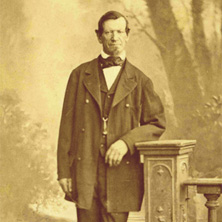 |
|
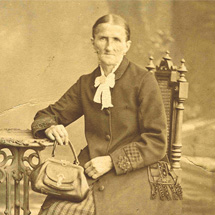 |
|
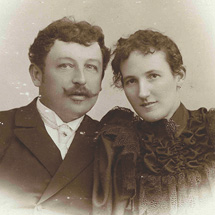 |
Ferdinand
Hlaváček (1822–1897)
|
Terezie Hlaváčková (1830–1896) |
František Černý (1865–1925)
and Marie Černá (1866–1932), née Hlaváčková |
Artistic Gardening
František Černý (1865–1925) married into the Hlaváček garden centre
in 1896. He learned gardening at the chateau in Smiřice nad Labem
and worked in Moravia after that. In 1888, he was appointed gardener
at the Hohe Warte Park owned by the Rothschild family in Vienna,
even more famous than the gardens at Schönbrunn. It is no exaggeration
to say that this was the university of the gardening arts. However,
František wanted to gain his independence. After having successfully
managed land-scaping for the “Music and Theatre Exhibition” in
Vienna in 1892, he was recommended to Prince Radziwill as head
gardener in the Russian part of Poland, but in fact started work
with his relatives, the Rembelinský family in Krośniewice. He was
given a luxurious flat, horses, a carriage, a sleigh and a good
wage.
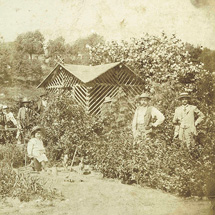 |
|
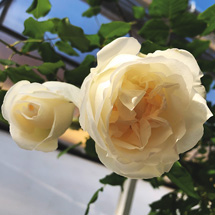 |
|
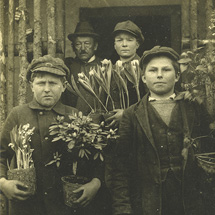 |
Courtyard in
František Černý’s garden (1865–1925) |
Original permanently flowering
Niphetos climbing rose bush
planted by František Černý
(1865–1925) |
František Černý (1865–1925)
with his apprentices |
While visiting Jaroměř, he met Marie Hlaváčková. She charmed him
and they got married. From chateau parks, he found his way to vegetable
growing and seed production. From orangeries with foreign flowers,
to commercial gardening. He honoured traditional practices, never
taking a liking for seed production. He preferred to devote his
time to growing flowers and excelled in artistic flower arrangement.
He also had other cultural interests. He enjoyed reading, wrote
short stories, acted and painted. A white Niphetos climbing rose
bush, which flowers all year round, still grows in our greenhouse
to this very day. František planted this bush in order to be able
to make up bouquets – even in winter.
Marie Černá (1866–1932), née Hlaváčková, married František Černý
as her second husband. She worked hard in the garden, but above
all devoted her efforts to the commercial side of the operation
of the garden centre – she travelled to market. This was held in
Jaroměř every Friday and was the main place for the sale of cultivars,
but also seeds.
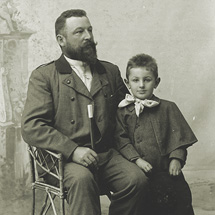 |
|
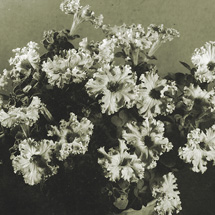 |
|
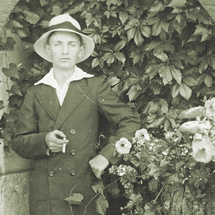 |
František Černý
(1865–1925)
with his young son František (1896–1968) |
Petunia h. fimbriata Maminka |
František Černý (1896–1968)
with petunias |
Seed Producers – Breeders
Another ancestor of the family, František Černý (1896–1968), returned
to seed production. His father did not want him to follow him into
gardening. He saw how much hard work it was and imagined his son’s
future differently. František was however born a gardener and in
the end managed to fight for his beloved career.
When his father was already very ill, František married Marie Mojžíšová
(1903–1987) from an old gardening family from Náchod. After his
father’s death, he specialised the business with a focus on seed
production with a clear goal: to shake the monopoly of German companies.
They started to engage in breeding of petunias and later also begonias,
lily-of-the-valley, salvia, cyclamens and cineraria.
 |
|
 |
|
 |
František (1896–1968)
and Marie Černá (1903–1987),
née Mojžíšová |
František Černý’s catalogue
(1896–1968) |
František Černý’s garden
centre in the 1940s |
In fact, this happened quite by chance. František saw some planters
in front of a seed company in Hradec Králové with large-flowered
overhanging petunia. They literally enchanted him and so he set
out for the promised land of petunias, Germany. He planted his
first petunia in 1927 and starting the next year, tried different
possibilities for pollination and selection of the most suitable
plants with his wife Marie. Their colourful colony grew. In 1934,
the Černý family launched their first own variety “Karkulka”, which
we offer in our range in a modified form to this very day. Then
came other original varieties. The petunias were joined by permanently
flowering begonias and tuberous begonias.
Marie Černá devoted her whole life to breeding tuberous begonias
and the result of this is beautiful full-flowered resistant varieties.
The Černý Seed Company gradually made its mark and production was
already unable to meet demand after the war. In 1950 however, František
had to lease his business to the state and it was completely expropriated
ten years later. Despite this, he did devote the rest of his life
to flowers. He too had a lot of cultural interests. He enjoyed
reading, acted in the theatre and kept in contact with people from
the artistic world. He was active in gardening social life, regularly
writing for the professional press. He was a characteristic and
respected personality in the field of gardening.
 |
|
 |
|
 |
Production crops
of petunia intended for production of seeds |
František (1896–1968)
and Marie (1903–1987) Černý
classifying begonias, 1967 |
Petunia h. fimbriata
Pozdrav z Jaroměře |
Hybrid Breeding
After World War Two, flower breeding in Jaroměř reached a completely
new level. The person responsible for this was František Černý’s
son Jan (1928–1980).
Jan first learned the gardening trade with his father. He met his
future wife Alenka Prokopová (1928–2000) at the gardening school
in the Moravian town of Lednice, where everybody who was truly
interested in this field caught up with their education after the
war. Alenka also came from a gardening family. Jan then continued
his studies at the Agricultural University in Brno. As a student,
he became acquainted with a pioneer of the new heterosis method,
Professor F. Frimmel. This truly fateful meeting led him to start
breeding hybrid varieties.
In 1959, Jan Černý launched the first hybrid variety of permanently
flowering begonias onto the market, the Turov F1. In 1960, he launched
the first hybrid petunia variety, the Lavina Bílá F1. He gradually
bred a comprehensive range of hybrid varieties of these flowers.
His wife Alenka also participated in breeding many of these.
 |
|
 |
|
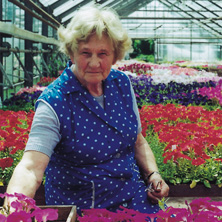 |
Jan Černý (1928–1980)
next to hotbeds with cyclamen |
Jan Černý (1928–1980)
and Alenka Černá (1928–2000),
née Prokopová |
Alenka Černá (1928–2000)
selecting petunias
for production of seeds |
His varieties were judged to be the best in international comparative
trials in Hannover. These varieties won several awards at garden
shows. One of his dreams come true was the yellow petunia, a shade
which does not naturally occur in petunias.
Jan Černý became an important and respected breeder on an international
scale. He also took an interest in the public greenery in Jaroměř
and performed an inventory of this. He died suddenly in 1980. The
valuable genetic material was only preserved in its scope and quality
thanks to his wife Alenka. It was not easy to perform the duties
which were originally performed by three people. The scope of breeding
work was huge.
The nationalised enterprise was incorporated for several years
into the Sempra state enterprise. Despite various problems, the
Černý family was able to continue the breeding work they had started.
The fruits of these efforts are modern varieties of petunia and
begonia which flower fans in the Czech Republic and abroad have
taken pleasure in for several years now.
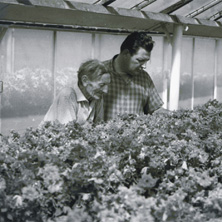 |
|
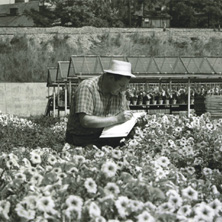 |
|
 |
| Jan Černý
(1928–1980) with his father František Černý (1896–1968),
1967 |
Jan Černý (1928–1980)
evaluating trial hybrids, 1967 |
The Novitas Olomucensis
award |
Rebirth and Present Day
A representative of the next generation, Jan Černý (1957–2016),
also devoted his life to flower breeding. The result of this is
a range of modern hybrid varieties of begonia and petunia.
Jan studied plant genetics at the Faculty of Science at Charles
University in Prague. While still studying at university, he married
Vlasta, née Broučková in 1978. Their first son, Jan, was born in
1978, a daughter, Veronica, in 1980 and a second son, Jakub, in
1991. After certain disagreements with the management of the then
state-owned enterprise Sempra, he had to abandon his work for a
short period in 1988. He did not however lose contact with the
breeding station in Jaroměř.
 |
|
 |
|
 |
| |
Jan Černý (1957–2016)
and the first free elections in 1990 |
Petunia h. fimbriata
Aphrodite F1 |
Then something happened at the start of 1991 which nobody had dared
to hope for anymore. The gardening business was returned to the
hands of its original owners, the Černý family, within the framework
of restitution and successfully built on its past tradition. After
November 1989, Jan Černý also got involved in public life in Jaroměř,
where he was politically active for three electoral terms (1990–2002)
as city councillor and for two electoral terms (1990–1998) as a
member of the town council. Jan enjoyed music – attending concerts
by his favourite musicians and bands and took a passionate interest
in cinematography. He also had a lifelong interest in art and very
much enjoyed travelling.
His two sons Jan Černý (1978) and Jakub Černý (1991) currently
work in and manage the company. They already represent the sixth
generation to continue the family tradition. Both among other things
studied at the Secondary Horticultural School in Mělník and at
the Faculty of Horticulture at Mendel University in Brno. The team
of experienced workers, some of which have been working in the
company for more than
25 years, guarantees the high quality of seeds produced.
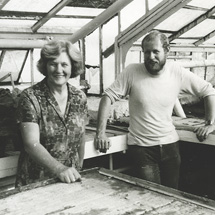 |
|
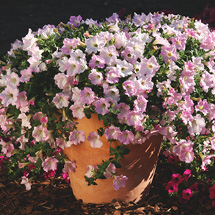 |
|
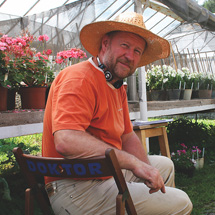 |
Jan Černý
(1957–2016) with his mother Alenka Černá (1928–2000) |
Petunia h. Diamond Pearly
Shades F1 |
Jan Černý (1957–2016)
at work breeding |
The Černý Seed Company is nowadays a highly specialised breeding
and seed production company. It is currently the only company in
the Czech Republic to launch new F1 hybrid flowers which it has
bred itself onto the market every year. The seeds which are produced
are constantly gaining in popularity and are successfully distributed
to customers all around the world. Plants which come from Jaroměř
are thus nowadays grown not only in Europe, but also in Asia, America
or for example on the Arabian Peninsula.
Since 1934, the Černý family has bred more than 130 original varieties
of petunia, begonia, cyclamen, lily-of-the-valley and other types
of flowers. Varieties bred in Jaroměř have won several medals at
international exhibitions and have been awarded the “Novitas Olomucensis”
prize three times. However, the most important thing is the fact
that they have retained their popularity among gardeners and flower
fans the whole time.
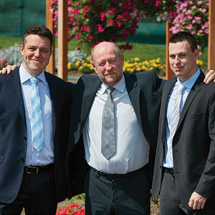 |
|
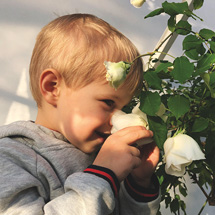 |
|
|
Jan Černý
(1957–2016) with his sons – Jan (1978) from the left
and Jakub (1991) from the right |
František Černý (2015)
next to the Niphetos climbing rose bush,
planted by his great-great-great-grandfather František
Černý (1865–1925) |
|

